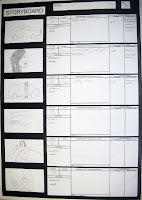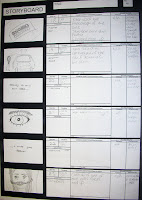What are some of the key conventions of the horror genre?
A genre is a sort of contract, agreement or set of expectations circulating between audience and institution. Audience is a very useful concept because it helps us decide which media we want to consume, in a very media saturated world. Genre is also beneficial because it minimises the financial risk by enabling the producers of media texts to target pre-existing audiences.
The boundaries of genre are blurry and therefore it can be hard to distinguish where one genre ends and another begins. Although no single text can contain all the conventions of a genre, there are very typical conventions for the horror genre.
Horror films are usually set in small communities or isolated places, this offers more opportunities for a sense of isolation, or for a whole community to harbour a secret. For example in Eden Lake the two main protagonists are isolated in the woods and in The Shining they are in an huge empty hotel and find themselves snowed in. They are often places with a past which will inevitably return, for example, an abandoned house; this is often referred to as “the return of the repressed.” The houses in horror films are usually big with lots of different floors, cellars and attics, with more room for secrets to inhabit. Usually in these films, in the light of day everything seems very normal and innocent, but night time is a whole different story, playing on our pre-existing fear of the dark.

This is a typical house that you would see in a horror film. A fairly modern house in a nice, friendly, normal looking neighborhood that doesn't look in any way scary on the outside. It is a big house with lots of levels and even a balcony.
The importance of the technical code is essential to the horror genre. The camerawork is expressive rather than naturalistic; a lot of canted, weird angles are used to disorientate the audience. A common lighting technique in horror is for the source of light to come from a low angle, casting shadows that are unnatural to us. We are used to light coming from above, like the sun or lightbulbs. Extreme close-ups on the victim are a very common feature in horror; it enables the audience to identify with them and creates tension because we can’t see past them and therefore we don't know where the monster is. Sudden extreme close-ups on the monster is a popular technique in horror, connoting invasion of our personal space. Point of view shooting is also very important, subjective, hand-held or steadicam camerawork often places the audience in the monsters eyes. Clover (Men, Women and Chainsaws) argues this usually switches to the victim/protagonist/final girl as the film progresses. Both of these raise the issues about audience identification. Camerawork often makes use of the depth of the frame, for example we will see the protagonist in the foreground, unaware of the monster emerging in the background. The editing often creates unsettling jumps from long shot to close-up, rather than the smooth use of medium shot which creates suspense for the audience. When the camera quickly jumps from long shot to close-up, it is often paired with a loud noise to make us jump. Sudden increases in editing pace when there is no apparent threat creates a feeling of jumpiness and keeps the audience on the edge of their seats. We often hear sounds which increase in pace, for example footsteps or heartbeats.

This is an example of low-angle lighting, the light is coming from the below which is an angle of light we are not used to. Also, this picture shows a common shot in horror films, the protagonist in the foreground and the monster emerging in the background.
Visual signifiers of the genre are readily apparent, the colours black and red have obvious connotations of blood, darkness, evil etc. The low-key, low angle lighting emphasises the shadows, something that is a common feature in horror films are they are mysterious. The light coming from down below connotes hell, bonfires, primitive instincts etc. A selection of the commoner objects in the mise-en-scene would include weapons (particularly bladed), blood, masks, icons of the supernatural (ghosts, moving objects) and religion (crucifixes, pagan symbols). Also, Levi Strauss’s theory on the iconography of childhood/innocence, for example this still from The Ring:

The classic realist Hollywood narrative structure is normality, enigma, path to resolution, closure, or hero, agent of change, quest, resolution, closure. This is largely applicable to genre, although there may be “false closures” and the real closure often left ambiguous for two reasons; to suggest mythic quality of the monster or to enable a sequel. This conception of narrative structure is based on Todorov’s theories. As a main protagonist, the “final girl” of the slasher and many other horror films is a victim/hero rather than a simple hero, and this provides a point of masochistic identification for the spectator which is more complicated than in many other genres, this is somewhat problematic in many horrors. The narratives of some sub-genres, such as the slasher, are very formulaic. A childhood psychotic event creates a killer who returns to a past location on an anniversary (return of the repressed) to kill again. It is usually a group of stupid, immoral teenagers, and the “final girl” is usually the virginal and slightly masculine girl. Often, horror uses the use of binary oppositions, for example innocence/evil, hence the use of dolls, fairgrounds, nursery rhymes etc. An example of this is at 1:00 in this trailer for A Nightmare On Elmstreet, we can hear a little girl singing. The contrast of her innocence and the horror that is going on around her make its really chilling and effective.
http://www.youtube.com/watch?v=B-tSvrkKx2Y
There are typical character types for this genre. The main protagonist is often the “victim/hero” – the person we identify with, the monster usually has a hidden secret or made psychotic by an earlier event and the stupid, immoral teens get killed. There are often children involved too, which relates back to the binary oppositions (innocence/evil). The police are never any good in horror films- they never save anyone.
Some interesting themes of horror is the binary oppositions theory, the return of the repressed and Freudian’s theory on how horror is often close to sex in some way, the hidden evil inside and the idea that watching these films lets out our “inner monster”, and the prolonging question- what lies on the other side of death?












































